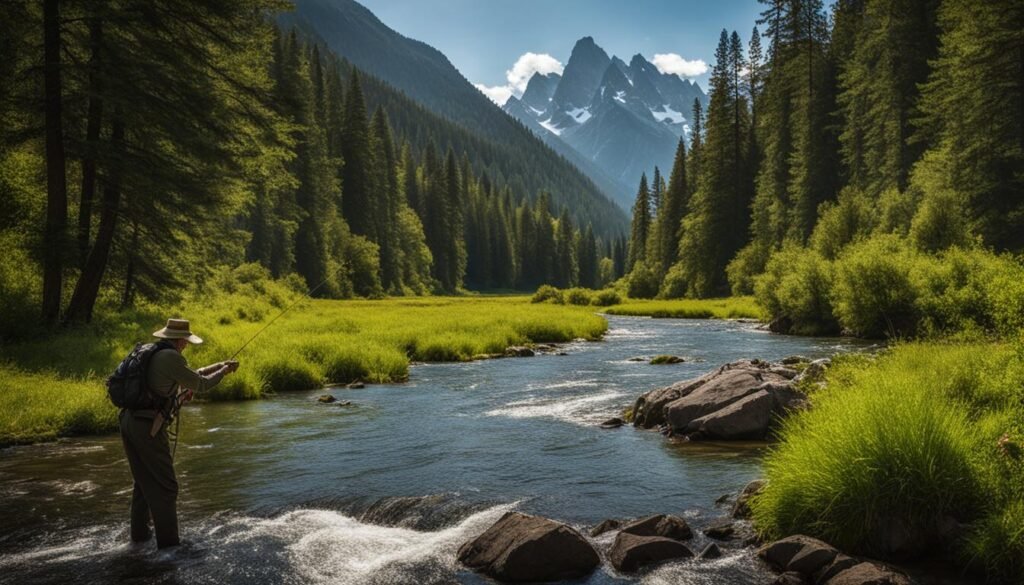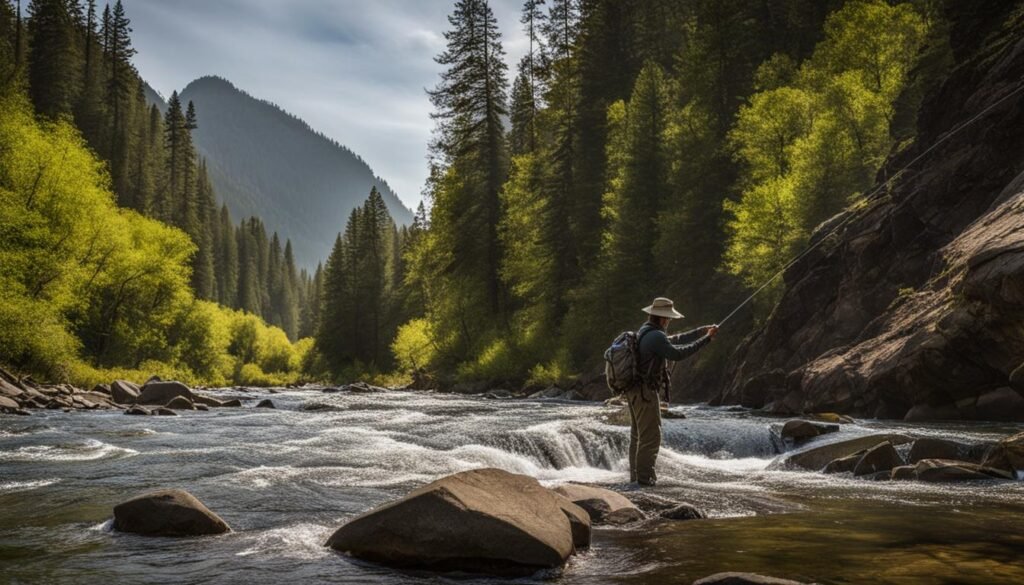The steeple cast is an essential casting technique any fly fisherman should learn. This technique is perfect for fishing in tight spots such as small creeks and rivers. It allows you to overcome obstacles and deliver your fly with precision.
In this guide, we’ll walk you through step-by-step tutorials, tips, and tricks to help you master the steeple cast.
The Basics of Fly Fishing
In the world of angling, fly fishing stands out as a serene and contemplative activity. To get started, it’s essential to understand the basics of this unique technique. Fly fishing involves using a long, flexible rod made of materials like fiberglass, bamboo, or carbon fiber.
Pairing the rod with an arbor reel, you’ll need a heavy line attached to a light leader, which connects to the fly. Flies are an integral part of fly fishing and can be crafted from natural or synthetic materials. These meticulously designed flies mimic insects or other fish prey.
When it comes to locations, fly fishing is primarily practiced in rivers and lakes, with trout being the main target species. Investing in quality fishing boots is crucial for comfort and keeping your feet dry. Understanding the gear and equipment necessary for fly fishing is key to ensuring success on the water.
Fly Fishing Basics Summarized:
- Use a long, flexible rod made from materials like fiberglass, bamboo, or carbon fiber
- Pair the rod with an arbor reel and attach a heavy line to a light leader, which connects to the fly
- Create flies that mimic insects or other fish prey using natural or synthetic materials
- Practice fly fishing in rivers and lakes, focusing on catching trout
- Invest in quality fishing boots for comfort and dryness
Tips and Tricks for Mastering the Steeple Cast

The steeple cast is a valuable casting technique that can greatly enhance your fly fishing skills, especially when you find yourself in tight or small creeks and rivers. It allows you to overcome obstacles and accurately deliver your fly to hard-to-reach spots. Mastering the steeple cast takes practice, but with these tips and tricks, you’ll be casting like a pro in no time.
To begin, focus on creating a high trajectory on your backcast. This allows you to gain the necessary height to clear any obstacles and ensure a smooth transition for your forward cast. Keep your wrist firm but not rigid, and let the rod do the work as you smoothly accelerate through the casting motion.
As you transition from your backcast to your forward cast, make sure to change your direction by 90 degrees. This change in direction is essential for accurately presenting your fly to the target. Aim for a delicate presentation, avoiding any harsh slapping of the water that could potentially scare away fish.
One of the keys to mastering the steeple cast is practice. Find a quiet spot where you can focus on your technique without distractions. Consider watching instructional videos on the steeple cast to visually learn the proper form and execution. By dedicating time to practice and honing your skills, you’ll become proficient in this casting technique and expand your fly fishing repertoire.
History and Evolution of Fly Fishing
Fly fishing has a long and fascinating history that spans centuries. It originated in Macedonia around 200 CE and gradually spread to different parts of the world. However, it was in America that fly fishing truly thrived, thanks to its abundance of fast rivers teeming with fish.
The development of fly fishing techniques in America was greatly influenced by the surrounding geography and the introduction of new transportation methods. In the northeastern part of the country, the Catskills region became a hotspot for fly fishing due to its pristine trout rivers. The advent of the steam train further popularized the sport, connecting these trout rivers to the eastern seaboard and making them accessible to a wider audience.
As fly fishing gained popularity, various regions within America developed their own unique techniques and traditions. For example, Northern Michigan is known for its excellent trout fishing, while the Pacific Northwest is famous for steelhead and salmon fishing. The Rocky Mountains offer breathtaking scenery and diverse fly fishing opportunities.
The Pioneers of Fly Fishing
- Mary Orvis Marbury: She published the influential book “Favorite Flies and Their Histories,” which showcased numerous fly patterns and techniques.
- Joan Wulf: A pioneer in women’s fly fishing and a strong advocate for conservation.
- Helen Shaw: Known for her work in teaching young anglers and promoting fly fishing as a family-friendly activity.
The contributions of these individuals, along with many others, have helped shape the rich and vibrant history of fly fishing in America. Today, fly fishing continues to evolve, with new techniques and technologies being developed to enhance the angler’s experience. Understanding the history and evolution of fly fishing allows us to appreciate the traditions and innovations that have made it the beloved sport it is today.
Advanced Fly Casting Techniques
Mastering advanced fly casting techniques can take your fly fishing skills to the next level. These techniques allow you to cast more accurately, increase distance, and overcome challenging fishing situations. Here are some advanced fly casting techniques that every angler should learn:
1. Reach Cast
The reach cast is a useful technique for presenting dry flies accurately, especially in tight or close quarters. It involves extending your arm and rod to reach around obstacles or to avoid drag on the fly. By using this technique, you can achieve a natural drift and increase your chances of enticing a strike.
2. Bow and Arrow Cast
In situations where there is limited space for backcasting, the bow and arrow cast comes in handy. This technique involves drawing the fly line back close to the rod tip and then quickly releasing it forward. This allows you to make accurate casts even in tight spots such as overhanging trees or brush.
3. Double Haul Cast
The double haul cast is a powerful technique that increases line speed and distance. It involves using both your rod hand and line hand to create additional tension on the line during the casting stroke. This technique is particularly effective for casting larger flies or when facing strong winds.
4. Tuck Cast
The tuck cast is commonly used by nymph fishermen to ensure their flies sink effectively and quickly. It involves stopping the rod abruptly during the forward casting stroke, causing the line to tuck under and the fly to enter the water with minimal disturbance. This technique is great for fishing deep pools or fast-moving currents.

